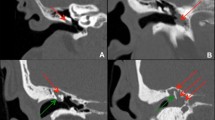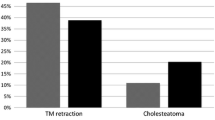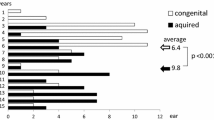Abstract
Purpose
Congenital cholesteatoma (CC) presents as a white pearl-like lesion behind a normal tympanic membrane (TM), without a history of otorrhea, infection, perforation or previous otologic surgery. Several recent studies provided new data improving this pathology characterization. The aim of this paper is to expand the knowledge about CC and to provide new insights on its pathogenesis.
Methods
The study consisted of two main research parts: (1) systematic review and meta-analysis; (2) medical literature review englobing anatomy, histology, embryology and congenital pathology of the ear.
Results
The search strategy identified a total of 636 papers. Seventy retrospective studies were included. A total of 1497 cases were studied and the mean age was 6.58 years, with a male–female ratio of 3:1, 34% were asymptomatic, 26% had hearing loss and 2% had facial dysfunction/paralysis. The overall estimate for antero-superior quadrant involvement was 0.70 [95% confident interval (CI) 0.64–0.76], in the postero-superior quadrant was 0.60 (95% CI 0.52–0.69), in the antero-inferior quadrant was 0.32 (95% CI 0.23–0.41), in the postero-inferior quadrant was 0.38 (95% CI 0.29–0.47), in the attic was 0.53 (95% CI 0.43–0.63) and in the mastoid was 0.33 (95% CI 0.26–0.41). More advanced Potsic stages were present in older patients. The most likely inclusion place seems to be between the pars flaccida and the upper quadrants of the pars tensa.
Conclusions
During the last decades, a substantial improvement in CC diagnosis and management had been achieved. The presented mechanism seems to explain most of middle ear CC.
Similar content being viewed by others
References
Bennett M, Warren F, Jackson G, Kaylie D (2006) Congenital cholesteatoma: theories, facts, and 53 patients. Otolaryngol Clin N Am 39:1081–1094
Persaud R, Hajioff D, Trinidade A, Khemani S, Bhattacharyya MN, Papadimitriou N, Kalan A, Bhattacharyya K (2007) Evidence-based review of aetiopathogenic theories of congenital and acquired cholesteatoma. J Laryngol Otol 121(11):1013–1019
Aimi K (1983) Role of the tympanic ring in the pathogenesis of congenital cholesteatoma. Laryngoscope 93:1140–1146
Northrop C, Piza J, Eavey RD (1986) Histological observations of amniotic fluid cellular content in the ear of neonates and infants. Int J Pediatr Otorhinolaryngol 11:113–127
Tos M (2000) A new pathogenesis of mesotympanic (congenital) cholesteatoma. Laryngoscope 110:1890–1897
Teed RW (1936) Cholesteatoma verum tympani: its relationship to the first epibranchial placode. Arch Otolaryngol 24:455–474
Michaels L (1986) An epidermoid formation in the developing middle ear: possible source of cholesteatoma. J Otolaryngol 15(3):169–174
Bacciu A, Di Lella F, Pasanisi E et al (2016) Open vs closed type congenital cholesteatoma of the middle ear: two distinct entities or two aspects of the same phenomenon? Int J Pediatr Otorhinolaryngol 78(12):2205–2209
Anthwal N, Thompson H (2016) The development of the mammalian outer and middle ear. J Anat 228(2):217–232
Gacek RH (1975) Diagnosis and management of primary tumors of the petrous apex. Ann Otol Rhinol Laryngol 84:1–20
Potsic WP, Samadi DS, Marsh RR et al (2002) A staging system for congenital cholesteatoma. Arch Otolaryngol Head Neck Surg 128:100912
The Jamovi project (2019) jamovi. (Version 1.0) [Computer Software]. https://www.jamovi.org. Accessed June 2019
DerSimonian R, Laird N (1986) Meta-analysis in clinical trials. Control Clin Trials 7:177–188
Deeks JJHJ, Altman DG (2011) Cochrane handbook for systematic reviews of interventions version 5.1.0 (updated March 2011). The Cochrane Collaboration
Cho HS, Kim HG, Da Jung Jung JHJ, Lee SH, Lee KY (2016) Clinical aspects and surgical outcomes of congenital cholesteatoma in 93 children: increasing trends of congenital cholesteatoma from 1997 through 2012. J Audiol Otol 20(3):168
Čvorović L, Đerić D, Vlaški L, Dankuc D, Baljošević I, Pavićević L (2014) Congenital cholesteatoma of mastoid origin: a multicenter case series. Vojnosanit Pregl 71(7):619–622
Cohen MA, Kuroiwa MA, Berkowitz RG (2011) Acquired cholesteatoma in children following congenital cholesteatoma surgery. Int J Pediatr Otorhinolaryngol 75(1):43–48
Darrouzet V, Duclos JY, Portmann D, Bebear JP (2002) Congenital middle ear cholesteatomas in children: our experience in 34 cases. Otolaryngol Head Neck Surg 126(1):34–40
Doyle KJ, Luxford WM (1995) Congenital aural cholesteatoma: results of surgery in 60 cases. Laryngoscope 105(3):263–267
El-Bitar MA, Choi SS, Emamian SA, Vezina LG (2003) Congenital middle ear cholesteatoma: need for early recognition—role of computed tomography scan. Int J Pediatr Otorhinolaryngol 67(3):231–235
Grundfast KM, Ahuja GS, Parisier SC, Culver SM (1995) Delayed diagnosis and fate of congenital cholesteatoma (keratoma). Arch Otolaryngol Head Neck Surg 121(8):903–907
Hidaka H, Yamaguchi T, Miyazaki H, Nomura K, Kobayashi T (2013) Congenital cholesteatoma is predominantly found in the posterior-superior quadrant in the Asian population: systematic review and meta-analysis, including our clinical experience. Otol Neurotol 34(4):630–638
Inokuchi G, Okuno T, Hata Y, Baba M, Sugiyama D (2010) Congenital cholesteatoma: posterior lesions and the staging system. Ann Otol Rhinol Laryngol 119(7):490–494
Jang CH, Jung EK, Sung CM, Kim SB et al (2016) Minimally invasive transcanal myringotomy for pediatric early stage congenital cholesteatoma. Int J Pediatr Otorhinolaryngol 90:1–4
Kashiwamura M, Fukuda S, Chida E, Matsumura M (2005) Locations of congenital cholesteatoma in the middle ear in Japanese patients. Am J Otolaryngol 26(6):372–376
Karmarkar S, Bhatia S, Khashaba A, Saleh E, Russo A, Sanna M (1996) Congenital cholesteatomas of the middle ear: a different experience. Am J Otol 17(2):288–292
Kim BJ, Kim JH, Park MK, Lee JH, Oh SH, Suh MW (2018) Endoscopic visualization to the anterior surface of the malleus and tensor tympani tendon in congenital cholesteatoma. Eur Arch Otorhinolaryngol 275(5):1069–1075
Kobayashi T, Gyo K, Komori M, Hyodo M (2015) Efficacy and safety of transcanal endoscopic ear surgery for congenital cholesteatomas: a preliminary report. Otol Neurotol 36(10):1644–1650
Kojima H, Tanaka Y, Shiwa M, Sakurai Y, Moriyama H (2006) Congenital cholesteatoma clinical features and surgical results. Am J Otolaryngol 27(5):299–305
Koltai PJ, Nelson M, Castellon RJ, Garabedian EN, Triglia JM, Roman S, Roger G (2002) The natural history of congenital cholesteatoma. Arch Otolaryngol Head Neck Surg 128(7):804–809
Lazard DS, Roger G, Denoyelle F, Chauvin P, Garabédian EN (2007) Congenital cholesteatoma: risk factors for residual disease and retraction pockets—a report on 117 cases. Laryngoscope 117(4):634–637
Lee SH, Jang JH, Lee D, Lee HR, Lee KY (2014) Surgical outcomes of early congenital cholesteatoma: minimally invasive transcanal approach. Laryngoscope 124(3):755–759
Lee CH, Kim MK, Kim HM, Won C, Shin TH, Kim SY (2018) Bilateral congenital cholesteatoma. Otol Neurotol 39(5):e336–e341
McGill TJ, MerchantS Healy GB, Friedman EM (1991) Congenital cholesteatoma of the middle ear in children: a clinical and histopathological report. Laryngoscope 101(6):606–613
Misale P, Lepcha A (2018) Congenital cholesteatoma in adults-interesting presentations and management. Indian J Otolaryngol Head Neck Surg 70(4):578–582
Nelson M, Roger G, Koltai PJ, Garabedian EN et al (2002) Congenital cholesteatoma: classification, management, and outcome. Arch Otolaryngol Head Neck Surg 128(7):810–814
Park KH, Park SN, Chang KH, Jung MK, Yeo SW (2009) Congenital middle ear cholesteatoma in children; retrospective review of 35 cases. J Korean Med Sci 24(1):126–131
Park JH, Ahn J, Moon IJ (2018) Transcanal endoscopic ear surgery for congenital cholesteatoma. Clin Exp Otorhinolaryngol 11(4):233
Soderberg KC, Dornhoffer JL (1998) Congenital cholesteatoma of the middle ear: occurrence of an” open” lesion. Am J Otol 19(1):37–41
Stapleton AL, Egloff AM, Yellon RF (2012) Congenital cholesteatoma: predictors for residual disease and hearing outcomes. Arch Otolaryngol Head Neck Surg 138(3):280–285
Swartz JD, Glazer AU, Faerber EN, Capitanio MA, Popky GL (1986) Congenital middle-ear deafness: CT study. Radiology 159(1):187–190
Tada A, Inai R, Tanaka T, Marukawa Y, Sato S, Nishizaki K, Kanazawa S (2016) The difference in congenital cholesteatoma CT findings based on the type of mass. Diagn Interv Imaging 97(1):65–69
Warren FM, Bennett ML, Wiggins RH, Saltzman KL, Blevins KS, Shelton C, Harnsberger HR (2007) Congenital cholesteatoma of the mastoid temporal bone. Laryngoscope 117(8):1389–1394
Yamatodani T, Mizuta K, Hosokawa K, Takizawa Y, Sugiyama K, Nakanishi H, Mineta H (2013) Congenital middle ear cholesteatoma: experience from 26 surgical cases. Ann Otol Rhinol Laryngol 122(5):316–321
Yammine FG, Abela A, Arcand P, Guerguerian A, Dufour JJ (2001) Anterior and posterior middle ear congenital cholesteatomas in children. J Otolaryngol Head Neck Surg 30(1):29
Yeo SW, Kim SW, Chang KH, Suh BD (2001) The clinical evaluations of pathophysiology for congenital middle ear cholesteatoma. Am J Otolaryngol 22(3):184–189
Zappia JJ, Wiet RJ (1995) Congenital cholesteatoma. Arch Otolaryngol Head Neck Surg 121(1):19–22
Al Balushi T, Naik JZ, Al Khabori M (2013) Congenital cholesteatoma in identical twins. J Laryngol Otol 127(1):67–69
Blake DM, Tomovic S, Jyung RW (2013) Congenital cholesteatoma in a 3-year-old. Ear Nose Throat J 92(4):189–190
Bukurov B, Babić B, Dimitrijević M, Folić M, Arsović N (2014) Congenital cholesteatoma of the middle ear: uncommon clinical presentation. Vojnosanit Pregl 71(5):503–505
Chung J, Cushing SL, James AL, Gordon KA, Papsin BC (2013) Congenital cholesteatoma and cochlear implantation: implications for management. Cochlear Implants Int 14(1):32–35
Derlacki EL, Harrison WH, Clemis JD (1968) Congenital cholesteatoma of the middle ear and mastoid: a second report presenting seven additional cases. Laryngoscope 78(6):1050–1078
Derlacki EL (1973) Congenital cholesteatoma of the middle ear and mastoid: a third report. Arch Otolaryngol 97(2):177–188
Fedok FG, Bellissimo JB, Wiegand DA (1990) Bilateral congenital aural cholesteatoma. Otolaryngol Head Neck Surg 103(6):1028–1030
Giannuzzi AL, Merkus P, Taibah A, Falcioni M (2011) Congenital mastoid cholesteatoma: case series, definition, surgical key points, and literature review. Ann Otol Rhinol Laryngol 120(11):700–706
Jang CH, Cho YB (2009) Osteoma of the incus with congenital cholesteatoma: a case report. Auris Nasus Larynx 36(3):349–352
Jang CH, Cho YB, Kim YH, Wang PC (2009) Congenital cholesteatoma associated with blue eardrum. In Vivo 23(1):163–166
Kansu L, Ozluoglu LN (2017) Congenital cholesteatoma together with ossicular chain anomaly. Eur Arch Otorhinolaryngol 274(2):1179–1182
Levi J, Grindle C, O’Reilly R (2012) Pie-slice tympanoplasty for transcanal removal of small congenital cholesteatoma. Int J Pediatr Otorhinolaryngol 76(11):1583–1587
Litman RS, Smouha E, Sher WH, Shangold LM (1996) Two cases of bilateral congenital cholesteatoma—usual and unusual presentations. Int J Pediatr Otorhinolaryngol 36(3):241–252
Lipkin AF, Coker NJ, Jenkins HA (1986) Hereditary congenital cholesteatoma: a variant of branchiooto dysplasia. Arch Otolaryngol Head Neck Surg 112(10):1097–1100
Liu JH, Rutter MJ, Choo DI, Willging JP (2000) Congenital cholesteatoma of the middle ear. Clin Pediatr 39(9):549–551
Melero GA, March AR, Aldrich I, Pinedo JT (2000) Facial paralysis: an unusual presentation of congenital cholesteatoma. Otolaryngol Head Neck Surg 122(4):615–616
Mierzwinski J, Fishman AJ, Grochowski T, Drewa S, Drela M, Winiarski P, Bielecki I (2016) Cochlear implant and congenital cholesteatoma. J Otolaryngol Head Neck Surg 45(1):8
Mueller DT, Schwetschenau EL, Isaacson G (2004) Occult contralateral congenital cholesteatoma: is the epidermoid formation theory enough? Am J Otolaryngol 25(4):285–289
Nagato T, Otaka R, Wada T, Kanai N, Harabuchi Y (2012) Congenital cholesteatoma isolated to the mastoid presenting as stricture of the external auditory canal. Int J Pediatr Otorhinolaryngol 76(5):754–756
Nicollas R, Tardivet L, Bourliere-Najean B, Sudre-Levillain I, Triglia JM (2005) Unusual association of congenital middle ear cholesteatoma and first branchial cleft anomaly: management and embryological concepts. Int J Pediatr Otorhinolaryngol 69(2):279–282
Nishizaki K, Yamamoto S, Fukazawa M, Yuen K, Ohmichi T, Masuda Y (1996) Bilateral congenital cholesteatoma. Int J Pediatr Otorhinolaryngol 34(3):259–264
Ries M, Kostić M, Ajduk J, Trotić R, Bedeković V (2017) A case of bilateral congenital middle ear cholesteatoma. Braz J Otorhinolaryngol 83(6):723–725
Rohlfing ML, Sukys JM, Poe D, Grundfast KM (2018) Bilateral congenital cholesteatoma: a case report and review of the literature. Int J Pediatr Otorhinolaryngol 107:25–30
Santhi K, Tang IP, Nordin A, Prepageran N (2012) Congenital cholesteatoma presenting with Luc’s abscess. J Surg Case Rep 2012(12):rjs026
Schwartz RH, Grundfast KM, McAveney WJ, Merida MA, Feldman B (1983) Congenital middle ear cholesteatoma. Am J Dis Child 137(5):501–502
Shigemi H, Kaneda N, Hori F, Watanabe N, Mogi G (1991) Congenital middle ear cholesteatoma: report of 3 cases. Auris Nasus Larynx 18(3):291–296
Sim MW, Stewart TA, Snissarenko EP, Xu HXO (2011) Congenital cholesteatoma involving the Eustachian tube. Int J Pediatr Otorhinolaryngol 75(4):600–602
Solmaz F, Akduman D, Haksever M, Gündoğdu E, Mescioğlu A (2015) Atypical presentation of congenital cholesteatoma in an adult case with good hearing result. Ann Med Surg 4(1):26–29
Tabook SMS, Abdel Tawab HM, Gopal NK (2015) Congenital cholesteatoma localized to the mastoid cavity and presenting as a mastoid abscess. Case Rep Otolaryngol 2015
Wehrs RE (1983) The sleeve autograft in congenital cholesteatoma. Ann Otol Rhinol Laryngol 92(6):571–576
Kazahaya K, Potsic WP (2004) Congenital cholesteatoma. Current opinion in otolaryngology & head and neck surgery 12(5):398–403
Esperança Pina J (2009) Anatomia Humana da Relação, 4th edn. Lidel, Lisboa, pp 1–606
Standring S, Gray H (2008) Gray’s anatomy, 39th edn. Churchill Livingstone/Elsevier, Edinburgh, pp 438–725
Gilberto N, Santos R, Sousa P, O’Neill A, Escada P, Pais D (2019) Pars tensa and tympanicomalleal joint: proposal for a new anatomic classification. Eur Arch Otorhinolaryngol. https://doi.org/10.1007/s00405-019-05434-4
De Greef D, Aernouts J, Aerts J, Cheng J, Horwitz R, Rosowski J et al (2014) Viscoelastic properties of the human tympanic membrane studied with stroboscopic holography and finite element modeling. Hear Res 312:69–80
Paço J (2003) Doenças do tímpano. Lidel, Lisboa, pp 1–212
Ruah CB, Schachern PA, Zelterman D, Paparella MM, Yoon TH (1991) Age-related morphologic changes in the human tympanic membrane: a light and electron microscopic study. Arch Otolaryngol Head Neck Surg 117(6):627–634
Mallo M, Schrewe H, Martin JF, Olson EN, Ohnemus S (2000) Assembling a functional tympanic membrane: signals from the external acoustic meatus coordinate development of the malleal manubrium. Development 127(19):4127–4136
Kitazawa T, Takechi M, Hirasawa T, Adachi N, Narboux-Nême N et al (2014) Developmental genetic bases behind the independent origin of the tympanic membrane in mammals and diapsids. Nat Commun 6:6853
Som P, Curtin H (2011) Head and neck imaging, 5th edn. Mosby, St. Louis, pp 1053–1441
Proctor B (1964) The development of the middle ear space and their surgical significance. J Laryngolotol 78:631–648
Knoppert D, Reed M, Benavides S, Totton J et al (2007) Paediatric age categories to be used in differentiating between listing on a model essential medicines list for children. Word Health Organ Position Pap 1(5)
Sunil S, Oommen N, Rathy R, Rekha VR et al (2014) Epidermoid cysts of head and neck region-case series and review of literature. Int J Odontostomatol 8(2):165–169
Potsic WP, Korman SB, Samadi DS, Wetmore RF (2002) Congenital cholesteatoma: 20 years’ experience at The Children’s Hospital of Philadelphia. Otolaryngol Head Neck Surg 126(4):409–414
Furutera T, Takechi M, Kitazawa T, Takei J et al (2017) Differing contributions of the first and second pharyngeal arches to tympanic membrane formation in the mouse and chick. Development 144(18):3315–3324
Burford CM, Mason MJ (2016) Early development of the malleus and incus in humans. J Anat 229(6):857–870
Michaels L, Soucek S (1991) Auditory epithelial migration. III. Development of the stratified squamous epithelium of the tympanic membrane and external canal in the mouse. Am J Anat 191(3):280–292
Maithani T, Pandey A, Dey D, Bhardwaj A, Singh VP (2014) First branchial cleft anomaly: clinical insight into its relevance in otolaryngology with pediatric considerations. Indian J Otolaryngol Head Neck Surg 66(1):271–276
Dutta M, Saha J, Biswas G, Chattopadhyay S, Sen I, Sinha R (2013) Epidermoid cysts in head and neck: our experiences, with review of literature. Indian J Otolaryngol Head Neck Surg 65(1):14–21
Liang J, Michaels L, Wright A (2003) Immunohistochemical characterization of the epidermoid formation in the middle ear. Laryngoscope 113(6):1007–1014
Carlson B (2004) Human embryology and developmental biology, 3rd edn. Elsevier/Mosby, Philadelphia, pp 1–497
Flint P, Haughey B, Lund V, Niparko J, Robbins T, Thomas R, Lesperance M (2015) Cummings otolaryngology: head and neck surgery, 6th edn. Mosby/Elsevier, Philadelphia, pp 2027–2037
Acknowledgements
The authors would like to thank to Jorge Domingues, MD and Deodato Silva, MD, for offering their help to improve this manuscript.
Funding
The authors have no funding or financial relationships to disclose.
Author information
Authors and Affiliations
Corresponding author
Ethics declarations
Conflict of interest
None of the authors has any conflicts of interest to declare.
Ethical approval
All procedures performed in studies involving human participants were in accordance with the ethical standards of the institutional and national research committee and with the 1964 Helsinki Declaration and its later amendments or comparable ethical standards.
Human and animal rights
This article does not contain any studies with animals performed by any of the authors.
Additional information
Publisher's Note
Springer Nature remains neutral with regard to jurisdictional claims in published maps and institutional affiliations.
Rights and permissions
About this article
Cite this article
Gilberto, N., Custódio, S., Colaço, T. et al. Middle ear congenital cholesteatoma: systematic review, meta-analysis and insights on its pathogenesis. Eur Arch Otorhinolaryngol 277, 987–998 (2020). https://doi.org/10.1007/s00405-020-05792-4
Received:
Accepted:
Published:
Issue Date:
DOI: https://doi.org/10.1007/s00405-020-05792-4








